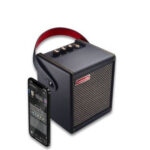Many guitarists, especially those new to digital modeling, seek to replicate the warm and natural tones of an acoustic guitar. If you’re using a Line 6 Pod Go, you might be wondering how to achieve the Best Acoustic Guitar sounds. After spending considerable time exploring the Pod Go, here are some key insights to guide you in that direction, drawing from experiences in maximizing the potential of this versatile unit.
Optimize Your Setup for Acoustic Tones
To truly appreciate the acoustic capabilities within Pod Go, ensure your setup is geared for accurate sound reproduction. Just as with electric guitar modeling, high-fidelity monitoring is crucial. Invest in quality studio monitoring headphones or FRFR (Full Range, Flat Response) speakers or studio monitors. These will provide a neutral and detailed soundstage, allowing you to hear the nuances of your acoustic patches without coloration from a traditional guitar amplifier. While some experiment with guitar amps, for the most direct and accurate acoustic sound, FRFR or studio monitors are the recommended path.
Explore Beyond the Presets for Acoustic Inspiration
The factory presets on the Pod Go, while showcasing its vast features, may not immediately offer the ideal acoustic guitar sound you’re seeking. Often, these presets are designed to demonstrate the breadth of effects and amp models rather than providing ready-to-use, refined acoustic tones. Don’t be discouraged if the initial presets don’t resonate with your acoustic vision. The true potential lies in crafting your own patches tailored for acoustic performance.
Embrace the Mic’d Acoustic Cabinet Concept
Think beyond the traditional electric guitar amp mindset and consider the world of mic’d acoustic guitar cabinets. This approach is fundamental to creating realistic acoustic tones digitally. Just as recording acoustic guitars often involves microphones capturing the instrument’s natural resonance, simulating this mic’d cabinet environment within Pod Go is essential. It might seem like an extra layer of complexity, but once you identify a few core acoustic sounds and understand how to tweak them, it unlocks a wealth of acoustic possibilities within your digital setup.
Master Low and High Cuts for Clarity
Understanding low and high-cut filters is a game-changer in achieving pristine acoustic tones. These filters are instrumental in removing unwanted frequencies that can muddy or harshen your sound. Properly applying low cuts eliminates unnecessary rumble and boominess, while high cuts tame excessive brightness or “fizz,” resulting in a clear, balanced, and natural acoustic guitar sound. Experiment with these tools; they are key to sculpting your desired acoustic voice.
Leverage Online Resources for Acoustic Patch Inspiration
Tap into the wealth of online resources, particularly YouTube, for inspiration and guidance. Search for videos focusing on Helix amp model tips and tricks – remember, Pod Go utilizes the same powerful amp and effects modeling technology as the Helix family. Many online creators share “recipes” for dialing in incredible sounds, including acoustic simulations. These videos often demonstrate best practices for signal chain order (e.g., compression, EQ, reverb, chorus), which are directly applicable to crafting acoustic patches on your Pod Go. Using a computer to edit your patches, mirroring the techniques shown in these videos, can significantly speed up your tone-crafting workflow.
Contextualize Your Acoustic Tone in Musical Settings
It’s easy to get lost in the minutiae of sound tweaking in isolation. Regularly play along with backing tracks or collaborate with other musicians. This practice is invaluable for shifting your focus from endlessly obsessing over minute sonic details to ensuring your acoustic tone sits effectively within a musical mix. Playing in context reveals what truly matters in achieving a great overall sound, preventing you from getting bogged down in unnecessary adjustments.
If you’re seeking a quick path to satisfying acoustic sounds on your Pod Go, start with a foundation of a clean preamp model – perhaps something transparent and neutral. Pair this with a touch of chorus for acoustic thickening, a subtle reverb to create space, and critically, an acoustic impulse response (IR). Acoustic IRs are pre-recorded sonic snapshots of real acoustic guitars and cabinets, and loading one into your Pod Go is the most direct route to instantly transforming your electric guitar or piezo-equipped acoustic into a convincingly amplified acoustic instrument. Investing in a quality acoustic IR collection will significantly expand your acoustic palette within Pod Go.
By focusing on optimized monitoring, exploring beyond presets, understanding mic’d cabinet simulation and EQ, utilizing online resources, and contextualizing your sound in musical situations, you can unlock the potential to create truly inspiring acoustic guitar sounds with your Line 6 Pod Go.

